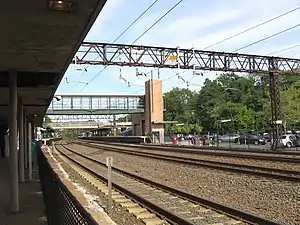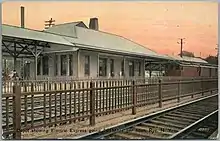Rye | |||||||||||||||||||||||||||||||||
|---|---|---|---|---|---|---|---|---|---|---|---|---|---|---|---|---|---|---|---|---|---|---|---|---|---|---|---|---|---|---|---|---|---|
 Rye station from the southbound platform | |||||||||||||||||||||||||||||||||
| General information | |||||||||||||||||||||||||||||||||
| Location | 2 Station Plaza Rye, New York | ||||||||||||||||||||||||||||||||
| Coordinates | 40°59′16″N 73°40′45″W / 40.987803°N 73.679123°W | ||||||||||||||||||||||||||||||||
| Owned by | Metropolitan Transportation Authority | ||||||||||||||||||||||||||||||||
| Line(s) | MTA New Haven Line (Northeast Corridor) | ||||||||||||||||||||||||||||||||
| Platforms | 2 side platforms | ||||||||||||||||||||||||||||||||
| Tracks | 4 | ||||||||||||||||||||||||||||||||
| Connections | |||||||||||||||||||||||||||||||||
| Construction | |||||||||||||||||||||||||||||||||
| Parking | 675 spaces | ||||||||||||||||||||||||||||||||
| Accessible | Yes | ||||||||||||||||||||||||||||||||
| Other information | |||||||||||||||||||||||||||||||||
| Fare zone | 14 | ||||||||||||||||||||||||||||||||
| History | |||||||||||||||||||||||||||||||||
| Opened | December 25, 1848[1][2] | ||||||||||||||||||||||||||||||||
| Passengers | |||||||||||||||||||||||||||||||||
| 2018 | 2,443 daily boardings[3] | ||||||||||||||||||||||||||||||||
| Services | |||||||||||||||||||||||||||||||||
| |||||||||||||||||||||||||||||||||
| |||||||||||||||||||||||||||||||||
Rye station is a commuter rail stop on the Metro-North Railroad's New Haven Line, located in the city of Rye, New York.
History

Railroad service through Rye dates back to the 1840s when the New York and New Haven Railroad laid tracks through the town and the city. The NY&NH was merged into the New York, New Haven and Hartford Railroad in 1872. In 1907 the main line was electrified through a major power plant across the state line in Cos Cob built by Westinghouse. Beginning on July 1, 1928, Rye became the northeastern terminus of the New Haven Railroad's affiliate, the New York, Westchester and Boston Railway, on a separate platform from the rest of the station.[4] By December 7, 1929 the line was extended to Port Chester and Rye served as the penultimate stop on the Port Chester Branch.[5] The NYW&B station closed on October 31, 1937, and the New Haven removed the rails in 1940. The New England Thruway was built on the site of the NYW&B station during the 1950s.
As with all New Haven Line stations in Westchester County, the station became a Penn Central station upon acquisition by Penn Central Railroad in 1969. The station was updated in 1972 from low-level to high-level platforms. This was done to accommodate the arrival of new rail cars known then as Cosmopolitans, now more commonly known as M2s. The new cars did not include boarding steps, or traps, as their predecessor 4400 Pullman "Washboard" cars did, and could only board passengers at stations with high-level platforms. The update was done in two phases, with the eastern half of the station upgraded first; then the western half. Due to the railroad's continuous financial despair throughout the 1970s, they were forced to turn over their commuter service to the Metropolitan Transportation Authority. For many years, Rye was the eastern Westchester County station for Amtrak,[6] with trains such as the Connecticut Yankee and Mail Express.[7] MTA transferred the station to Metro-North in 1983, and Amtrak moved to New Rochelle in October 1987.[8]
Station layout
The station has two high-level side platforms each 10 cars long.[9]: 19
As of August 2006, weekday commuter ridership was 2,470, and there are 696 parking spots.[10]
| M | Mezzanine | Crossover between tracks |
| P Platform level |
Side platform, doors will open on the right | |
| Track 3 | ← New Haven Line toward Grand Central (Harrison) | |
| Track 1 | ← New Haven Line express trains do not stop here ← Amtrak services do not stop here | |
| Track 2 | Amtrak servies do not stop here → New Haven Line express trains do not stop here → | |
| Track 4 | New Haven Line toward Stamford (Port Chester) → | |
| Side platform, doors will open on the right | ||
| Street level | Exit/entrance and parking | |
Bibliography
- Jenkins, Stephen (1912). The Story of the Bronx from the Purchase Made by the Dutch from the Indians in 1639 to the Present Day. New York, New York: G.P. Putnam's Sons. Retrieved December 12, 2019.
References
- ↑ Jenkins 1912, p. 235.
- ↑ "Special Express Notice". The Evening Post. New York, New York. February 12, 1849. p. 3. Retrieved December 9, 2019 – via Newspapers.com.

- ↑ Metro-North 2018 Weekday Station Boardings. Metro-North Railroad Market Analysis/Fare Policy Group. April 2019. p. 6.
- ↑ Rye NYW&B Station; (New York, Westchester and Boston Railway website)
- ↑ Port Chester NYW&B Station (New York, Westchester and Boston Railway website)
- ↑ Amtrak June 11, 1972 Schedule (Museum of Railway Timetables)
- ↑ Amtrak April 5, 1987 Schedule (Museum of Railway Timetables)
- ↑ Amtrak October 25, 1987 Schedule (Museum of Railway Timetables)
- ↑ "Metro-North Railroad Track & Structures Department Track Charts Maintenance Program Interlocking Diagrams & Yard Diagrams 2015" (PDF). Metro-North Railroad. 2015. Retrieved January 28, 2019.
- ↑ "Metro-North Station Statistics". The New York Times. August 2006.